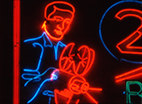In the Stone House
- Jerome Hiler |
- 2012 |
- 35 minutes |
- COLOR/B&W |
- SILENT
Rental Format(s): 16mm film, 18 fps / Digital File / Digital File - DCP
New revised version available, Spring 2024
IN THE STONE HOUSE, as a project, spans my lifetime as a filmmaker. The images date from the mid 1960s to 1970. These scenes have remained as camera original since that time and were part of a larger body of work that gradually disappeared over the years through viewings, re-editing, damage and misplacement. At some point, they were put away and forgotten about. In 2012, Mark McElhatten asked me if I had a film or some material to show on a bill with Nathaniel Dorsky's rushes for SONG AND SOLITUDE. I remembered my early material and said I would have a "film" to show. The material had already been assembled on a reel for a screening of random footage in 2004 at LUX in London. In 2012, I made a new film from the footage that made up the London screening.
It was a challenge to work with such fragmentary footage. The temptation to treat it drastically and fragment it further to reach a new form met with the needs of an old filmmaker who found himself repeatedly surprised by private messages and revelations exhaling from the images - along with a trace of vinegar. On one hand, I was engaged in the shaping of a film as a difficult artistic struggle and, on the other, I was confronting personal understandings that reflected the whole spectrum of my good and bad traits, which were unchanged even as I worked. I sometimes regretted having to deal with a project that ripped myself open to myself. I wanted to turn away, but I made a commitment and had to continue.
Because I was dealing with remnants, I didn't have the freedom and flexibility that comes with a contemporaneous project. People have noted the use of black in the film. Black, for me, has the sense of rejuvenating the consciousness in an inner space of darkness. It both connects and disconnects which brings it close to mental functions. When the film starts, the images emerge from black as if flares illuminated the dark landscape. But, it eventually takes on other purposes: it serves a live function in joining fragments.
The images come from a life lived by Nathaniel Dorsky and myself as we sought refuge from life in Manhattan in the later 1960s. I feel that the 1960s are no longer understood properly. As the period slips further and further away, we are left with cartoonish images - and some of them are justified. Yet, as with all movement eras, there was a core of people who had uncommon understanding of what the human dilemma of the time was and how one could find a worthy life that transcended the degradations that seemed overwhelming. Understanding came from going beyond the forms and promises of materialism. The mind became a frontier of vast spirituality rather than the calculator of facts and figures. There was a tremendous interest in psychedelic drugs, some of which completely nullified the most basic assumptions of ordinary logic. At its core therefore, the Sixties was a time of spiritual search. Naturally, when it comes to mass movements, there will only be a few who seriously remain true to such an ideal - and even among them there were plenty of clowns. Into this tapestry, add two young filmmakers who took themselves to a remote, rural area of northern New Jersey to unobtrusively usher in the New Age of.....you name it, it was coming. We were lucky to find a great house on a lake below a mountain for $85.00 a month. Although we were now close to nature, we were also surrounded by neighbors who all seemed to have stepped out of a D W Griffith film. Flinty Yankees who had never seen a Democrat except on television. And we wanted to explore our minds. So, in our new home, discretion was the order of the day. I went around dressed like a country gentleman in tweed, which singled me out beautifully. Even so, we were visited every weekend by the most conspicuous, lavishly hippest of the hip Manhattanites. One particularly hairy giant hitched his way to a point around ten miles away on the main route. The cops were too curious and asked who he was and where he was going. "Oh. Nick and Jerry's" was his answer. The cops nodded and said "The stone house" and sent him on his way. So much for my tweedy look.
IN THE STONE HOUSE follows the course of three seasons. There is a strong conjunction between the energies of the natural world and the youthful mind of the filmmaker newly in love with both film and the material world. For me, the sense of observation is more important than the thing observed. I often record everyday things. There are trips to Manhattan, as well as to my parents in working-class Queens. I don't see this as "diaristic" as if it had no significance to anyone but myself. When I am shooting film, I am inviting the viewer inside myself to that area that usually seems unreachable in human exchanges. Every art, such as painting or music, has that special area that is disallowed to all other forms. With film, you can inhabit my mind.
Note: requests for 16mm print rentals must specify Tungsten or Xenon balanced prints
Rental Fees
| Fee | ||
|---|---|---|
| 16mm film, 18 fps | $200.00 | |
| Digital File | $200.00 | |
| Digital File - DCP | $200.00 |



